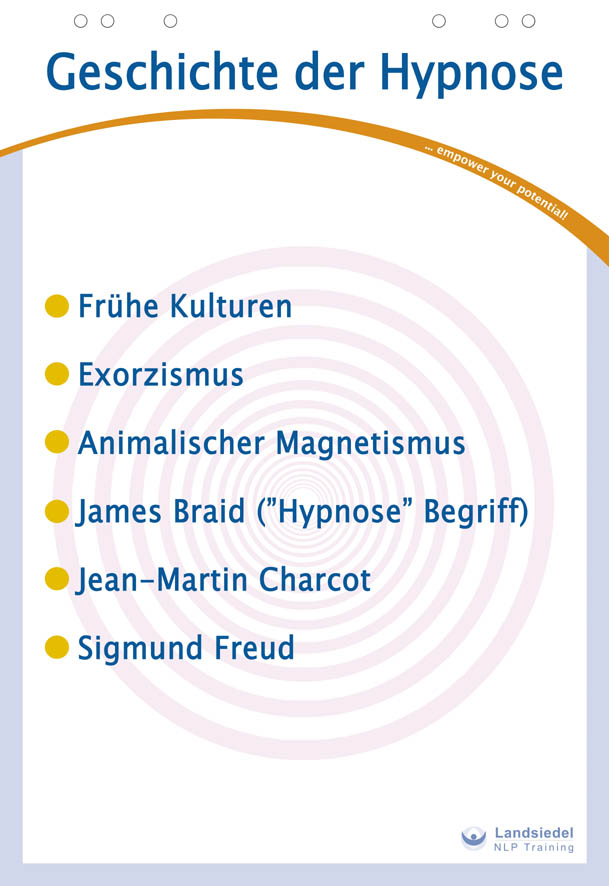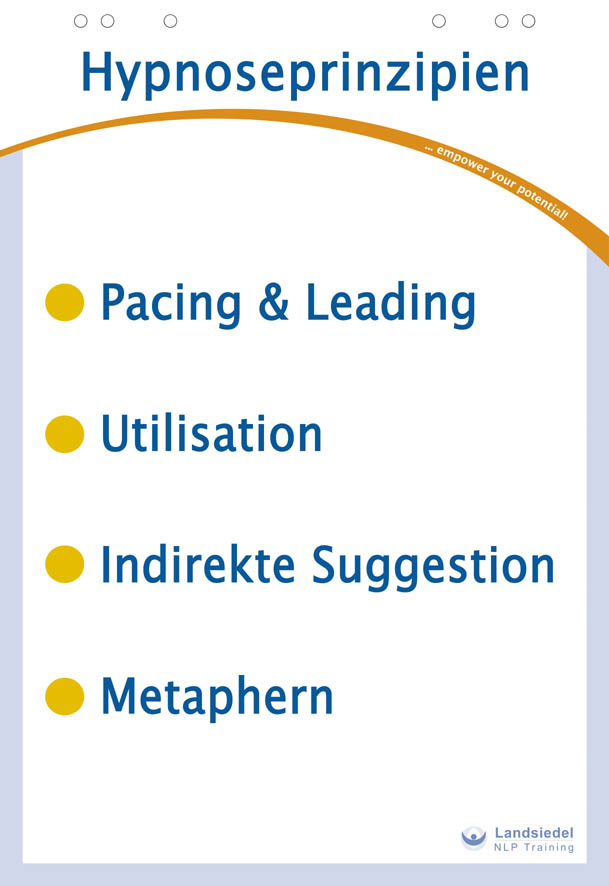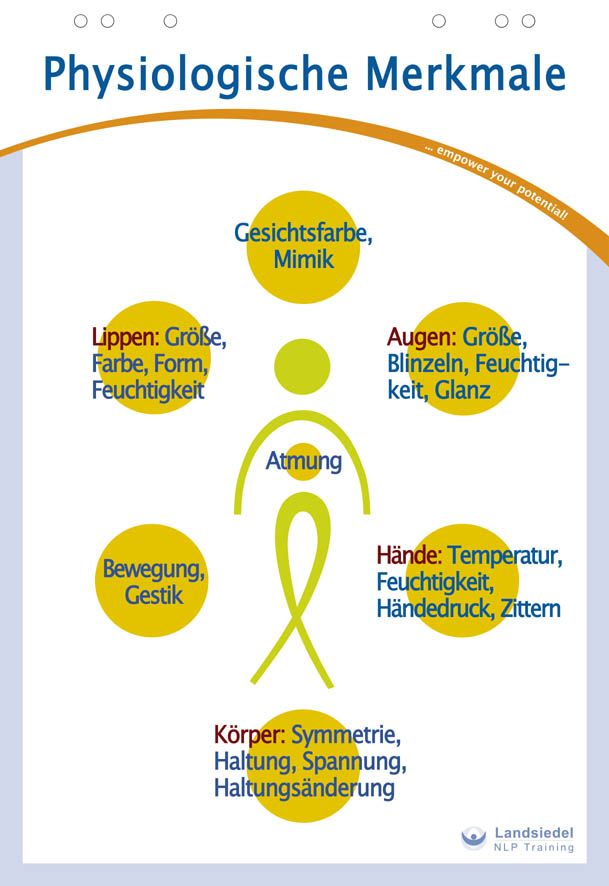Paths to the Unconscious – NLP and Hypnosis
Open the doors to your unconscious potential by learning and applying the language patterns of the Milton Model. Hypnotic language patterns allow access to trance states and thereby to levels of awareness that would otherwise remain closed to you.
A word in advance
Whenever John Grinder and Richard Bandler run a hypnosis seminar together, one of them eventually says: “Actually, all communication is hypnosis,” and the other replies: “I must disagree. Nothing is hypnosis—there is no such thing as hypnosis.” In a certain sense, they mean the same thing, and both are right. If by hypnosis we understand anything that changes a state of consciousness, then every successful communication is hypnosis.
Prejudices and objections to hypnosis
Few topics stir people up like “hypnosis.” Many prejudices and objections are voiced by laypeople who have seen so‑called stage hypnosis on TV and let their imagination run wild.
- The hypnotist exerts control over a person who has become will‑less (the marionette theory). Hypnosis is best understood as an imaginative therapeutic method that depends on the client’s capacity and willingness to imagine. Clients always have insight into their behavior and actively co‑determine what happens within the communication by reporting their imaginings and cognitions. The will is by no means switched off.
- The myth of magic. Most people do not know the phenomena that can occur under hypnosis nor how to explain them. They are therefore attributed to magic by the uninitiated. In fact, there are now many scientific studies on different hypnosis phenomena.
- “I can’t be hypnotized.” Anyone who wants to be can, in principle, be hypnotized. It simply requires the right induction method. As a hypnotist, your main task is to find what someone naturally responds to.
- “I was still wide awake and could hear everything.” If you hear and see nothing, you are dead. Under hypnosis, perception is usually more intense, not less.
- Hypnotizability is about character strength (weak‑willed, easily influenced). There is no empirical evidence for this. IQ also has no impact on hypnotizability. Studies do show correlations with certain mental abilities such as absorption (the ability to become fully immersed in an activity), imagination, and probably creativity.
Why learn hypnosis?

This section explores the advantages hypnosis can bring and why it’s worthwhile to engage with it.
- Hypnosis and hypnotic language can be used in every area of daily life and at any time.
- Unfold your personality, increase flexibility, and expand life options—at play, at work, in love, and in sales.
- Everyone has experienced altered states of consciousness—for example, falling asleep, riding a bike on “autopilot,” or going to the basement and forgetting what you wanted.
- Clinical uses include quitting smoking, losing weight, wisdom‑tooth extraction, fear management, and pain reduction.
- If unconscious processes predominantly follow learned and automated patterns, it makes sense to pursue change directly at that level.
Further information on learning hypnosis.
Definitions
The terms hypnosis and trance are defined and briefly explained.

- A trance state is a state of consciousness that differs from the ordinary. Typically, the client is relatively still and turns attention inward to an internally retrieved or created experience. Trance is not sleep, and physiologically it cannot be clearly distinguished from meditation and relaxation. However, hypnosis is not identical with relaxation, since trance phenomena can be elicited without bodily relaxation, and—unlike relaxation—hypnotizability itself cannot be trained. Even so, trance is not unique; it overlaps with everyday waking “micro‑trances,” such as highway hypnosis or getting lost in a good book.
- Hypnosis is the art or science of helping another person reach an altered state of consciousness. We do this all the time—the systematic method is what matters. One of the chief tools is language.
- Transderivational search is the process of seeking meaning from memory and imagination in response to something said, heard, or seen, e.g., “Everyone knows times when they feel that everything they worked for seems worthless—all that they believed in until now…”
Definitions of “altered states of consciousness”
- Any state of consciousness that differs from your usual state.
- A state in which your attention is so intensely focused on an object or process that all other perceptions fade into the background.
- Activity of the non‑dominant cerebral hemisphere.
- A state in which attention is directed inward.
History of hypnosis
This section offers a brief tour of the history of hypnosis. Hypnosis is among the oldest rituals of humankind and has been practiced for thousands of years.

- Early cultures
Hypnosis has been used for millennia across cultures and for various purposes—for example, temple sleep in ancient Egypt. - Exorcism
Catholic priest Johann Joseph Gassner (1727–1779) once believed the devil was attempting to possess him and subsequently applied Catholic exorcism rites—similar to hypnotic suggestion—successfully on himself and later on others. - Animal magnetism
German physician Franz Anton Mesmer (1734–1815) is considered a forerunner of modern hypnotherapy. He theorized that illness results from an imbalance in “animal magnetism.” A commission could not confirm this, yet his great therapeutic successes are undisputed and are attributed to suggestive influence. Although incorrect, his approach represented the first scientific attempt to explain hypnosis. - James Braid
(Scottish physician and surgeon, 1795–1860) coined the term “hypnosis.” Since Braid, the source of healing has been sought less in the magnetizer and more in the patient. - Charcot
(French neurologist, 1825–1893) successfully used hypnosis with patients diagnosed with hysteria. - Freud
later became skeptical of hypnosis, which is one reason it waned in popularity during his period of influence.
Principles of hypnosis
An outline of the principles of the indirect form of hypnosis advocated by Dr. Milton Erickson. The typical Ericksonian principles are:

1. Utilization
Hypnotic suggestions are not meant to be imposed on clients or force them to do anything. Instead, they aim to activate or modify the natural mental mechanisms and associations that already exist in the client (Erickson, Rossi & Rossi, 1978). This means, for example, allowing a client who seems inclined to move to actually move, or incorporating existing fears into the process. The goal of utilization is to elicit a “yes‑set” in the client and thus avoid resistance—or even use it therapeutically. Utilization is a powerful way to build a trusting therapeutic relationship (rapport).
2. Indirect suggestions
These prevent resistance before it arises. “The verbalizations for induction and during therapy are not given directly as instructions, but in a special form of communication. The patient is continually affirmed and can develop or maintain a yes‑set.” (Kossak, 1989, p. 134). The idea behind indirect suggestions is to facilitate new response options and, independently of conscious will, to trigger automatic unconscious searches (Erickson & Rossi, 1981). Erickson’s indirectness was the true innovation—though he could do it all: direct or indirect, permissive or authoritative, depending on what fit.
3. Pacing and leading
(Pacing & Leading): Pacing includes, among other things, describing or even mirroring the client’s observable behavior (e.g., posture): “You are sitting comfortably in your chair, legs crossed, and waiting…” This builds a yes‑set. After some time pacing, the therapist can begin to lead—introducing planned interventions while staying attuned to the client. For example, during induction the therapist initially matches the client’s breathing rate; as the client shows signs of relaxation (slower, deeper breathing), the therapist slightly slows their own breath, prompting the client to breathe even more slowly and relax more deeply.
4. Metaphors
Erickson often told stories, fairy tales, puns, symbols, or anecdotes with multiple layers of meaning. Telling a complex story or metaphor distracts the conscious mind and activates an unconscious search for meaning and resources. With an effective metaphor that models a solution, the relationships among the story elements mirror the relationships within the problem. When this is the case, the unconscious can understand and implement the metaphor (O’Connor & Seymour, 1994).
He placed great value on keeping the analogy out of conscious awareness. If he noticed a client was catching on, he would change the topic immediately—creating amnesia through distraction.
The benefits of metaphorical communication are clear: stories are non‑threatening; they capture conscious attention and support client autonomy. Clients can assign their own specific meaning to a story’s message, depending on their background. Sometimes stories can also create confusion and increase a person’s readiness for hypnosis.
The imperative is only implicit, which helps bypass resistance to change.
Basic principles of hypnosis
Possible perceptions in altered states of consciousness:
- Feelings of lightness in the head, neck, or throughout the body
- A humming in the head; a calm, pleasant feeling
- Slowed heart rate and breathing
- Tingling or pulsing in fingers/toes
- Dissociated body sensations

Possible external signs of altered states (trance signals):
- Muscle tone:
Relaxation of muscles, especially in the face, neck, shoulders, and hands. - Pupil dilation (a “fixed” gaze)
- Breathing: slower, calmer, more even; more diaphragmatic (belly) breathing
- Pulse: slowing (sometimes visible at the neck or temple)
- Reflexes such as blinking or swallowing slow down or pause
- Eyes may water
- Change in skin color on cheeks and neck
- Body movements slow; the body appears still
Possible internal signs of altered states:
- Reduction of stress hormones
- Lower breathing and heart rates, blood pressure, and metabolic rate
- More alpha‑wave activity in the right hemisphere
- Changes in blood chemistry
- Narrowed focus of attention
- Altered body perception
- Image‑based thinking
- Trance logic
Read more:

 Deutsch
Deutsch English
English Français
Français 中文
中文 Español
Español नहीं
नहीं Русский
Русский